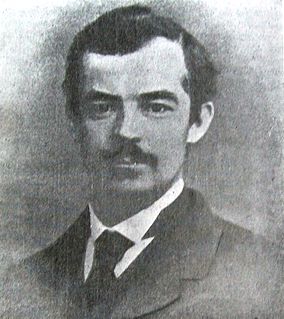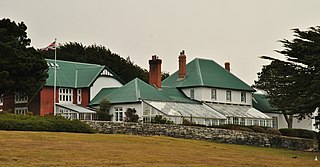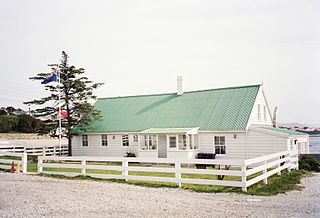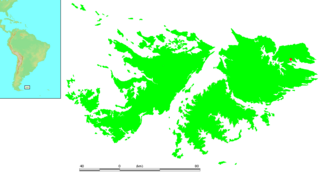 W
WThe history of the Falkland Islands goes back at least five hundred years, with active exploration and colonisation only taking place in the 18th century. Nonetheless, the Falkland Islands have been a matter of controversy, as they have been claimed by the French, British, Spaniards and Argentines at various points.
 W
WAjax Bay is a settlement on East Falkland, in the Falkland Islands, It is on the north west coast, on the shore of San Carlos Water, a few miles from Port San Carlos. It was mainly a refrigeration plant, and was developed by the Colonial Development Corporation in the 1950s, which was also responsible for developing Port Albemarle. It was supposed to freeze Falkland mutton, but this was found to be economically inviable. Many of the pre-fabricated houses were moved to Stanley.
 W
WThe Aurora Islands was a group of three phantom islands first reported in 1762 by the Spanish merchant ship Aurora while sailing from Lima to Cádiz. The Aurora's officers reported sighting them again in 1774. The Spanish ship San Miguel fixed their location at 52°37'S, 47°49'W. On 20 February 1794, they were sighted again by a Spanish survey ship, the corvette Atrevida, which as part of the Alejandro Malaspina circumnavigation had been sent to confirm them. Their reported location was approximately halfway between the Falkland Islands and South Georgia at 53°S 48°W. The latitude is considered perfect, the longitude was based on the meridian of the astronomical observatory, San Fernando, Cádiz. The islands were last reportedly sighted in 1856, but continued to appear on maps of the South Atlantic until the 1870s.
 W
WThe Battle of the Falkland Islands was a First World War naval action between the British Royal Navy and Imperial German Navy on 8 December 1914 in the South Atlantic. The British, after their defeat at the Battle of Coronel on 1 November, sent a large force to track down and destroy the German cruiser squadron. The battle is commemorated every year on 8 December in the Falkland Islands as a public holiday.
 W
WThomas Bridges was an Anglican missionary and linguist, the first to set up a successful mission to the indigenous peoples in Tierra del Fuego, an archipelago shared by Argentina and Chile. Adopted and raised in England by George Pakenham Despard, he accompanied his father to Chile with the Patagonian Missionary Society. After an attack by indigenous people, in 1869 Bridges' father, Despard, left the mission at Keppel Island of the Falkland Islands, to return with his family to England. At the age of 17, Bridges stayed with the mission as its new superintendent. In the late 1860s, he worked to set up a mission at what is now the town of Ushuaia along the southern shore of Tierra del Fuego Island.
 W
WThe British Nationality Act 1983 is an Act of Parliament passed by the Parliament of the United Kingdom on 28 March 1983. The purpose of the Act was to grant British citizenship to residents of the Falkland Islands, a British Overseas Territory in the South Atlantic.
 W
WThe Capture of Port Egmont on 10 June 1770 was a Spanish expedition that seized the British fort of Port Egmont on the Falkland Islands, garrisoned since 1765. The incident nearly led to an outbreak of war between Great Britain and Spain, known as the Falklands Crisis.
 W
WThe Falklands Expedition occurred in late 1831 when the United States Navy warship USS Lexington was dispatched to investigate the seizure of three whalers at the small Argentine settlement of Puerto Luis. Founded in the ruins of the former Spanish penal colony of Puerto Soledad by Luis Vernet, the settlement sought to control sealing in the islands. Finding one of the ships being outfitted with guns, Captain Duncan seized six of the senior officers in the settlement on charges of piracy. The damage done to the settlement is disputed. Duncan reports spiking the guns of the settlement and a powder store. Vernet was to later claim his settlement was ransacked.
 W
WGovernment House in Stanley has been the home of the Falkland Islands' Governors since the mid-19th century. The official residence was built in 1845.
 W
WHope Place was a small settlement in Lafonia in East Falkland. It was set up in 1846, by Samuel Lafone, a Montevideo merchant, on the south shores of Brenton Loch. It was mainly populated by Uruguayan gauchos brought in from continental South America. The area is now abandoned.
 W
WDavid Jewett is known for his role in the sovereignty dispute between the United Kingdom and Argentina. He was an American naval commander in the Quasi-War with France and following the end of that conflict he offered his services as a Mercenary in both Argentina and Brazil. Licensed as a privateer by the United Provinces of the River Plate to seize Spanish ships, he was later accused of piracy following the seizure of US and Portuguese flagged vessels. He finished his career in the Brazilian Navy, serving under Lord Cochrane and died in Rio de Janeiro in 1842.
 W
WThe Legislative Council of the Falkland Islands was the unicameral legislature of the Falkland Islands from 13 November 1845 until 1 January 2009. The new constitution came into force in 2009 and replaced the Legislative Council with the Legislative Assembly of the Falkland Islands.
 W
WThis is a list of buildings and structures in the Falkland Islands designated as being of architectural or historic interest, updated per 19 January 2006.
 W
WMoody Brook is a small watercourse that flows into Stanley Harbour on East Falkland, Falkland Islands. It is near Stanley, just to the north west, and was formerly the location of the town barracks, which were attacked in Operation Azul, the 1982 Argentine Invasion of the Falkland Islands.
 W
WFalkland Islanders derive from various origins. Earliest among these are the numerically small but internationally diverse early 19th century inhabitants of the Falkland Islands, comprising and descended in part from settlers brought by Luis Vernet, and English and American sealers; South American gauchos who settled in the 1840s and 1850s; and since the late 1830s, settlers largely from Britain with a minority from other European countries. There has also been significant recent contributions from Saint Helena and Chile.
Pepys Island is a phantom island, once said to lie about 230 nautical miles north of the Falkland Islands at 47°S. Pepys Island is now believed to have been a misidentified account of the Falkland Islands.
 W
WPort Albemarle is a settlement on West Falkland, in the Falkland Islands. It is in the far south of the island, on the east side, at the southern end of Falkland Sound.
 W
WPort Egmont was the first British settlement in the Falkland Islands, on Saunders Island off West Falkland, and is named after the Earl of Egmont.
 W
WPort Louis is a settlement on northeastern East Falkland. It was established by Louis de Bougainville in 1764 as the first French settlement on the islands, but was then transferred to Spain in 1767 and renamed Puerto Soledad.
 W
WPuerto Soledad was a Spanish military outpost and penal colony on the Falkland Islands, situated at an inner cove of Berkeley Sound.
 W
WPedro Sánchez de la Hoz was a Spanish merchant, conquistador and adelantado who served as secretary to Pizarro. In 1534 he obtained the rights of a capitulación de conquista south of the Straits of Magellan. He was appointed by Charles V, Holy Roman Emperor as an adelantado of Terra Australis in 1539.
 W
WThe sinking of Chian-der 3 was an incident that occurred on 28 May 1986, when the Taiwanese-flagged trawler Chian-der 3 was detected, tracked, fired upon, set on fire and eventually sunk by the Mantilla-class patrol vessel PNA Prefecto Derbes of the Prefectura Naval Argentina, at a location 24 nautical miles outside the United Kingdom's Total Exclusion Zone, which covers a circle of 200 nautical miles from the centre of the Falklands Islands. Two Taiwanese fishermen were killed; four others were injured.
 W
WAdmiral of the Fleet Sir Frederick Charles Doveton Sturdee, 1st Baronet was a Royal Navy officer. After training as a torpedo officer, he commanded two different cruisers and then three different battleships before becoming commander of the 1st Battle Squadron of the Home Fleet. He went on to command the 3rd Cruiser Squadron and then the 2nd Cruiser Squadron.
 W
WThe Falkland Islands have a complex history stretching over five hundred years. Active exploration and colonisation began in the 18th century but a self-supporting colony was not established till the latter part of the 19th century. Nonetheless, the islands have been a matter of controversy, as due to their strategic position in the 18th century their sovereignty was claimed by the French, Spaniards, British and Argentines at various points.
 W
WWeddell Island is one of the Falkland Islands in the South Atlantic, lying off the southwest extremity of West Falkland. It is situated 1,545 km (960 mi) west-northwest of South Georgia Island, 1,165 km (724 mi) north of Livingston Island, 606 km (377 mi) northeast of Cape Horn, 358 km (222 mi) northeast of Isla de los Estados, and 510 km (320 mi) east of the Atlantic entrance to Magellan Strait.
 W
WThe Falkland Islands wolf, also known as the warrah and occasionally as the Falkland Islands dog, Falkland Islands fox, or Antarctic wolf, was the only native land mammal of the Falkland Islands. It became extinct in 1876, the first known canid to have become extinct in historical times.